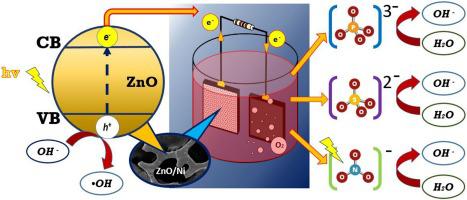Journal of Water Process Engineering ( IF 7 ) Pub Date : 2020-06-30 , DOI: 10.1016/j.jwpe.2020.101479 Yong-Por Ong , Li-Ngee Ho , Soon-An Ong , Johar Banjuraizah , Abdul Haqi Ibrahim , Sin-Li Lee , Noradiba Nordin

|
Developing an effective interface interaction between photoanode and electrolyte is crucial for achieving superior photocatalytic fuel cell (PFC) performance. In this aspect, the contribution of the medium or electrolyte properties in the PFC system such as dye concentration, ionic nature and active radicals play a decisive role. Herein, we constructed a PFC with ZnO loaded nickel foam (ZnO/Ni) photoanode to study the influence of initial dye concentration, pH and supporting electrolytes of different polyatomic anions on the PFC performance. The optimum initial dye concentration and pH for the PFC with reactive red 120 as organic pollutants were found to be 30 mg L−1 and 7.5, respectively. The PFC performance can be synergistically enhanced by the addition of three types of polyatomic anions (Na3PO4, Na2SO4 and NaNO3) as supporting electrolytes. In turn, PO43- had the greatest influence on the reduction of internal resistance (highest short circuit current, Jsc) which corresponded to the conductivity of dye solution. Eventually, the higher charge of polyatomic ions could contribute to higher energy conversion efficiency in PFC. Nonetheless, SO42- anions favoured the cleavage of aromatic compounds by the advantage of recycling between SO42- and SO4 - through hole scavenging activity. Comprehensively, our findings provided new insight into the selection of supporting electrolyte as well as the proposed mechanism of active radicals involved in PFC. Additionally, the ZnO/Ni photoanode demonstrated its excellent recyclability as it retained high PFC performance after five consecutive runs.
- through hole scavenging activity. Comprehensively, our findings provided new insight into the selection of supporting electrolyte as well as the proposed mechanism of active radicals involved in PFC. Additionally, the ZnO/Ni photoanode demonstrated its excellent recyclability as it retained high PFC performance after five consecutive runs.
中文翻译:

电解质中不同多原子离子对光催化燃料电池发电和染料脱色的比较研究
开发光阳极与电解质之间的有效界面相互作用对于实现优异的光催化燃料电池(PFC)性能至关重要。在这方面,PFC系统中介质或电解质性质的贡献,例如染料浓度,离子性质和活性自由基起着决定性的作用。在这里,我们构建了一个带有ZnO泡沫镍(ZnO / Ni)光电阳极的PFC,以研究初始染料浓度,pH和不同多原子阴离子的支持电解质对PFC性能的影响。发现具有反应性红120作为有机污染物的PFC的最佳初始染料浓度和pH分别为30 mg L -1和7.5。通过添加三种类型的多原子阴离子(Na 3PO 4,Na 2 SO 4和NaNO 3)作为支持电解质。相应地,PO 4 3-对降低内阻(最大短路电流,J sc)的影响最大,这对应于染料溶液的电导率。最终,多原子离子的较高电荷可能有助于提高PFC中的能量转换效率。尽管如此,SO 4 2-阴离子由SO之间循环的优点青睐的芳族化合物的裂解4 2-和SO 4 - 通孔清除活动。总的来说,我们的发现为支持电解质的选择以及PFC中涉及的活性基团的提议机理提供了新的见解。此外,ZnO / Ni光电阳极具有出色的可回收性,因为它在连续运行五次后仍保持了较高的PFC性能。
通孔清除活动。总的来说,我们的发现为支持电解质的选择以及PFC中涉及的活性基团的提议机理提供了新的见解。此外,ZnO / Ni光电阳极具有出色的可回收性,因为它在连续运行五次后仍保持了较高的PFC性能。



























 京公网安备 11010802027423号
京公网安备 11010802027423号